| Spectrum Software Scene |
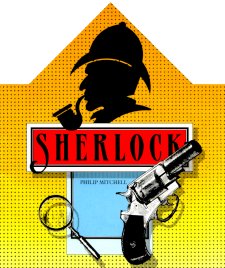
THE GREAT Holmes would no doubt have been appalled by the sensationalism accorded to his powers by the new Melbourne House game, but the company has produced an adventure in Sherlock to rival The Hobbit in terms of atmosphere and sophistication. The most striking feature is the way in which the characterisation has been developed. Hobbit fans will recall how characters had a habit of wandering off in all directions or sitting on the ground and singing about gold.
In Sherlock you can not only talk to other characters, of whom there are at least thirteen, and ask them to do things for you, but you can also interrogate them and even discuss the case. For example, saying to Watson "Tell me about the gun" may or may not elicit information, where as a sentence such as "Watson killed the Major" will, even if addressed to nobody in particular, register with other characters in the same location who may alter their actions accordingly.
That, coupled with the Melbourne House use of Inglish whereby the player's input is not limited to nouns and verbs but includes natural sentences such as "Quickly open the front door, go through the door and immediately hail a cab", ensures a high degree of realism. It is unnerving to have other characters, notably Inspector Lestrade of Scotland Yard, asking you questions such as "Well Holmes, have you any evidence to prove Watson killed Major Ffoulkes yet?" based on what you said earlier in the game.
The game itself opens in Holmes' study in Bake Street, with Watson seated in an armchair with the daily newspaper. It is up to you to discover what the case is about, and throughout the game, as in The Hobbit, you will need to use other characters to help you. Without wishing to give anything away, we can warn you the crime is fiendish, and the plot very complicated. We twice thought we had solved the crime after many hours playing, only to discover a new piece of evidence which blew each theory to pieces.
There are few of the logic problems whereby you need a specific object to continue to new locations, but plenty of evidence is lying about to be pieced together. As in the original stories, Holmes not only has to worry about solving the crime, but also saving the innocent, as the bumbling and self-satisfied Lestrade - beautifully portrayed - rapidly makes up his own mind as to who is guilty.
Thus the game is also a race against time, and a clock is provided on screen showing the time of day to the nearest minute. That is of the utmost importance not only as a guide to how well you are doing but also for catching trains on time. Since there is no train timetable provided, you will have to find out the schedule for yourself. Do not be surprised if your first few attempts are spent wandering around Victorian London; you will have to use the Underground system and hansom cabs very efficiently in order to be at the right place at the right time.
The graphics are not up to Hobbit standard. They occupy only a small section of the screen - about a quarter - but given that limitation are pleasing to the eye.
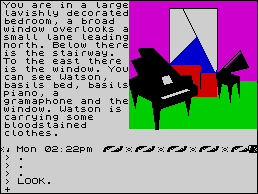
We also discovered the odd bug in the program. At one point a previously impeccably polite cabbie said "You bloody snob. Don't ever try to get into my cab again", whereupon the program printed out a long list of locations, and promptly crashed. On the other hand, probably deliberately, when night fell and we suggested to Watson that he go to sleep, the faithful old coot replied: "Brilliant, Holmes". He even tried to climb into Holmes' armchair when Holmes was sitting in it. Conan Doyle would have turned in his grave.
Melbourne House say in the instructions that the game cannot be guaranteed bug-free, because of the enormous number of possible events involved with character interaction. That did not seem to put people off The Hobbit, and the discovery of new Hobbit bugs became a minor growth industry in its own right. Since we can probably expect similar cries of delight from the hackers over Sherlock, perhaps Melbourne House should be given the benefit of the doubt.
Familiarity with the Sherlock Holmes stories will help you play the game, although not as directly as a knowledge of Tolkien helps solve The Hobbit. In particular, you should remember that Holmes never unravelled a case by deduction alone, but had great powers of observation. You cannot solve the mystery without the aid of the police, but you will need to strike out on your own account to improve on their performance. The police are also capable of obliterating the evidence, so make sure you see what you need to see early on. Then you can start checking the various suspects' alibis and begin to draw conclusions.
Although there is no book with the game, as in the case of The Hobbit, the instruction booklet contains a few clues in the form of examples to help you start. At £14.95 Sherlock cannot be considered cheap, but on the other hand it did take 18 months to develop, and has finally been released six months later than expected. The wait has been worthwhile.
Chris Bourne
| SHERLOCK | Memory: 48K | Price: £14.95 | Gilbert Factor: 9 |
DESPITE adversities, the evil Magra and her creators, Carnell Software, have survived to offer inveterate adventure game players further mind-bending challenges. Long-awaited, The Wrath of Magra takes the adventure program one step nearer to full role-playing scenarios.
As in other Carnell adventures there are three episodes, each a program in its own right. Successful completion of one will provide the data password into the next.
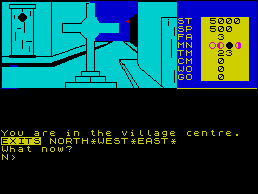
With the package comes The Book of Shadows, a lengthy chronicle densely packed with information on the world of Magra. The second part of the book catalogues the creatures who inhabit this dangerous world. Attached to the creature catalogue is a grimoire, a book of spells. By careful study the player will learn how and when to gather magical ingredients and how to combine them to create spells which can be stored for combat or defence.
Although the Princess Edora was rescued from the Volcanic Dungeon she remained bewitched. Magra's body was returned to the Black Mountains by her Ice Giants and there restored to a demonic travesty of life. Her powers are intact and she now thirsts for revenge. No one dares face her but you, driven as you are by the need to bring Edora back to the world of light.
At the beginning of the first episode you are placed in the valley of Di'Lief, where magic is powerless. Here you will have the opportunity to collect or purchase weapons or magical items and to find the way into the mines beneath the Black Mountains. The second episode takes you through those grim caverns where fearful monsters roam, guarding the entry into Magra's fortress. In the third and final part the adventurer must brave further savage creatures to encounter and destroy the witch herself. There are prizes for the first twenty successful warriors.
The screen display is in three parts. At the upper left appear the graphics. In the first episode pictures of the locations are shown, in the second the monsters are depicted, and in the final episode a map of the castle.
The upper right of the screen holds the status indicator, showing strength in points, spiritual power and faith. To make spells effectively the player needs faith and the more spells are cast the higher the faith value becomes. The time of day is displayed along with the phase of the moon. Certain spells can only be made in a particular phase and the player must take care to avoid wasting ingredients and power by performing magic at the wrong time.
A combat percentage is given which tells you what your chance of defeating an adversary is. The bottom half of the screen is for information and input, in standard text adventure style.
The computer keeps three main inventories for the player. There is the normal list of equipment and treasure and two specialised lists of magic phials, which contain spell ingredients, and spell cloths. Those cloths hold prepared spells ready for use in combat or similar situations.
The response to input is quite slow, but any Dungeons and Dragons fans will forgive this minor problem as the game is highly complex. In fact, the interpreter will take long entries of up to 59 characters which gets round the slow response time and cuts down on stop-start keyboard routines. Commands are also linkable.
A separate combat mode is used which not only takes account of spells and weaponry but balances strength and defence capabilities, similar to the routines used in Volcanic Dungeon.
Carnell have obviously made every effort to include as many aspects of role playing games as possible. Those efforts seem to have paid off. The Wrath of Magra takes a different direction from games like The Hobbit or Valhalla and acts as a Dungeonmaster for the player. Its sophistication should not be measured in terms of its ability to understand long sentences but by its strength in allowing the player to develop a comprehensive character whose identity will depend on conscious decisions and choices, not simply programmed chance.
Richard Price
| WRATH OF MAGRA | Memory: 48K | Price: £12.50 | Gilbert Factor: 8 |
A PROGRAM review is not the place to begin a discussion of dyslexia, a term hotly disputed among educationalists. Suffice it to say that Dyslexia Beater is aimed at children of average or above average ability from seven to 14 who experience reading difficulties, confuse left and right and muddle certain letters such as p, b and d.
Three levels of difficulty can be chosen, and three games are provided. In the Desert of Durg the player has to work through a maze of mines by pressing the cursor keys, first with the mines displayed and later when they are invisible. A mine detector screen indicates where the mines are.
In Crossing the Brax the player has to move a target right or left, to catch letters which match the target. Each successful catch builds an arch of a bridge.
Escape from Dyslexon involves steering a rocket ship through the green space gates while watching for flashing direction instructions. Refuelling has to be done by catching a yellow pod. Vaporisation occurs if the player is hit three times.
Compiled in machine code, the games are fun and fast moving. A useful learning aid for use either in special classes or at home.
Theo Wood
| DYSLEXIA BEATER | Memory: 48K | Price: £9.95 | Gilbert Factor: 8 |
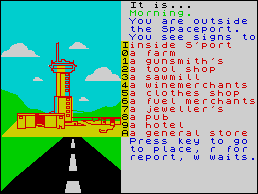
A TOUGH simulation of galactic trading, Star Trader, from Bug-Byte, combines commercial cunning with arcade action to tax even the most wily Arthur Daley of the spaceways. Set in the crumbling, inflation-racked economy of the far future, the game features gangs of vicious pirates who roam the space trade routes preying on hard-pressed entrepreneurs who are attempting to keep the isolated communities supplied with the basic needs of civilised life.
As a businessman your motives are not totally philanthropic and you aim to rake in as much profit as possible by buying cheap, selling dear and reducing your overheads. Rapacity and greed rule the universe and customs men, shopkeepers and criminals will do their best to rip you off or beat you up. Cash is also drained by the need to eat and drink frequently.
The simulation section consists of a number of menu-driven screens. The primary menu allows you to enter the stores of the commodity brokers, the spaceport or the pubs. Commodities can be bought in bulk and after a hazardous space trip are sold on to other planets. Report screens give details of prices on each planet and also provide cargo inventories and financial information.
The space trip is an arcade sequence featuring the onslaught of the pirates. The player can fight or surrender, but the 'tax' levied by these interstellar Mafiosi is enormous. If planets run out of goods their civilisations collapse and limit your market.
The program is well designed with fast keyboard response and clear screen displays. Static graphic illustrations adorn the simulation sections. Success in all parts of the game is hard-won and careful planning is needed, especially in calculating the size of a bribe. All in all Star Trader is a complex multi-task simulation which may well have you head-banging your Spectrum in frustration.
Richard Price
| STAR TRADER | Memory: 48K | Price: £ | Joystick: Kempston, Protek, Interface 2 | Gilbert Factor: 7 |
LIKE OTHER educational adventure games Castle of Dreams, from Widgit Software, has a quest, locations and directional movement related to compass points. The quest is the removal of Klingsor's casket of evil spells from the castle. It differs from other adventures in that to move from certain locations the player has to complete a series of tasks.
Those tasks range from code breaking in the parchment room to tables testing across the mosaic floor. Widgit has ensured that effort does not go unrewarded, as the time allowed for key entry is slowed down after each unsuccessful attempt, making the task easier.
The program teaches mapping, and directional techniques, but has extra tasks which can operate on several levels.
Theo Wood
| CASTLE OF DREAMS | Memory: 48K | Price: £7.95 | Gilbert Factor: 7 |
DESCRIBED as an animated cartoon adventure Rapscallion from Bug-Byte is more a series of hazardous arcade screens interlinked and controlled by a central theme. The villain Rapscallion has stolen the title deeds to your castle and hurled you into the dungeon. A fairy princess turns you into a bird which enables you to escape.
From the dungeon you move through an assortment of rooms each of which contains various human, animal or physical dangers. Your aim is to find gems and informative pixies.
In the first section, the Wilderness, the task is to find a key to the Magic Labyrinth and a shield which will protect you from the guard. Once that is achieved the wizards who protect the castle gate must be approached, again after many dangers. If you avoid Rapscallion and enter the castle you will then need a magic wand to defeat him and win the deeds.
In all the sections you must trace and enlist the aid of friendly magical creatures. Losing a life turns you into a ghost. That lets you explore the screens of the current section unharmed but to continue the exploration properly your ghost must be reunited with your body. Making a map is recommended. In each new game the helpers and gems which give help are relocated.
Although the graphics seem rather blocky, the range of obstacles is enormous. There is also a save-game option. The graphics are not as sophisticated as Atic Atac or Manic Miner but Rapscallion is still a difficult and complex game.
Richard Price
| RAPSCALLION | Memory: 48K | Price: £6.95 | Joystick: Kempston, Fuller, Protek, Interface 2 | Gilbert Factor: 6 |
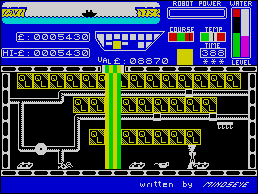
IN THE LATEST hit from Silversoft, Worse Things Happen at Sea, you are a ship's android, with sole responsibility for the safety of the ship as it ferries its cargo between two ports. Unfortunately the vessel is not merely leaky, it is a positive sieve. There are two decks and you must travel backwards and forwards patching up the holes and pumping out water.
The screen shows a crisp picture of the compartment you are in, and gives information concerning the status of your engines, whether you are off course, and an overall plan of the ship.
As the game progresses the hull springs leaks, with cartoon-like fountains bursting out of the floor. Those can be capped with a limited supply of plates, and there are also pumps which you can operate to remove water. You will find yourself rushing madly around the ship trying to stem the encroaching seawater; be careful opening doors between compartments as you may simply spread the water around.
The main criticism is the lack of provision for joysticks, although you can choose from a set of six key configurations, which should work with most joysticks as long as you know which keys your joystick uses.
Worse Things Happen at Sea is exciting to play, difficult to beat, and unusual in concept. Despite the joystick quibble, worse things have happened in computer games, too.
Chris Bourne
| WORSE THINGS HAPPEN AT SEA | Memory: 48K | Price: £5.95 | Gilbert Factor: 7 |
CRAZY CRANES from Voyager Software has a straightforward arcade concept behind it. The player must perform the same task over and over again and, as the score builds up, speed increases and other dangers are introduced.
The screen depicts a dock crane and a loading bay beneath it. The crane's arm stretches out over the water and the player must move the hook along the arm. Ships loaded with several different types of cargo move across the screen toward the crane and the cargoes are hooked by lowering the winch.
When five items are safely stowed in the bay the next level is reached. If the player misses an item it will disintegrate on the edge of the dock. After a few levels missiles cut across the dock and sever the hook.
The graphics are drawn simply, though they are adequate given the restricted scope of the game. Like many of these repetitive games, the task can become compulsive though the lack of real variation counts against it.
Richard Price
| CRAZY CRANE | Memory: 16K | Price: £5.50 | Gilbert Factor: 5 |
CARD GAMES such as Bridge enjoy obvious benefits from computerised versions, which can act as tutors in enhancing players' skills. Games of chance are another matter as the excitement lies in the bluffing and risk taking. Computers cannot provide the atmosphere and tension which comes from human interaction.
MFM Software have produced Double Dealer, a program which offers both Blackjack - pontoon - and five card Stud Poker. In both options the cards are displayed clearly on a green background with a prompt and betting window beneath.
In Blackjack the player can split, stick or twist as well as lay out money from the initial float of £3,000. The Poker option allows you to raise, fold or look at your own blind card and offers four levels of play, each with larger financial limits on each bet.
There is no two-player option and that could be seen as a severe limitation especially since the player's only inputs are to register bets or to make decisions on folding, sticking and so on. After a time the whole business seems rather passive, hardly the fantastic, superb and exciting game promised by the hyperbole of the cassette inlay.
Richard Price
| DOUBLE DEALER | Memory: 48K | Price: £6.50 | Gilbert Factor: 5 |
THE CONSTRUCTION of monsters is a laborious task at best, but the job is made doubly difficult in Frank N Stein from PSS. Not only do you have to collect the spare parts before you switch on the juice, but there are numerous smaller monsters and hazards threatening your project as well.
The game bears a close resemblance to Manic Miner, in that you must leap from platform to platform to collect the objects you need, dodging the various hazards.
When the monster is assembled, alive and kicking, he goes on the rampage, and you must climb to the switch to turn him off. Unfortunately, Frank cannot endure solitude, so back he goes to construct a new monster.
Derivative though it may be, Frank N Stein is fun and well-presented. PSS claims there are fifty screens in the game, so it should keep Manic Miner fans occupied for a few weeks. The graphics are neat and do suggest a Victorian-style mansion without being over-fussy in detail.
Chris Bourne
| FRANK N STEIN | Memory: 48K | Price: £5.95 | Joystick: Protek, Kempston, Interface 2 | Gilbert Factor: 7 |
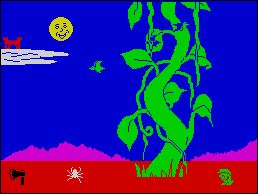
ONCE UPON a time Jack was going to market to sell the family cow. But on the way he met a sales rep from Thor who offered him a copy of Jack and the Beanstalk in exchange for the animal. Jack said "Whoopee", and took the game home.
Jack's mother was hopping mad when she found out what Jack had done and sent him to bed with no dinner. So Jack loaded the game and began to play.
He was very impressed by the graphics on the first screen, which showed a giant beanstalk climbing into the clouds. Avoiding the spider and the birds, he collected his magic axe and began to climb. After failing off about forty times he got the hang of it and soon found himself at the foot of the giant's castle. Unfortunately there seemed to be no way of progressing further; some of the blocks could be climbed but as far as getting up the whole wall went, Jack could find no way of doing it.
While playing the game Jack noticed that the colours were not very well organised, as they spilled over onto other parts of the picture, and the moving objects flickered, causing his eyes to ache. When his mother came in the next morning she found Jack huddled under the bed, completely blind and muttering to himself.
Moral: Just because a game has pretty pictures doesn't mean it's worth more than a bag of old beans.
Chris Bourne
| JACK AND THE BEANSTALK | Memory: 48K | Price: £5.95 | Joystick: Kempston, Cursor | Gilbert Factor: 5 |
CP SOFTWARE produces a range of traditional games for the Spectrum. Those computerised versions are invariably competent and testing though they naturally lack the feel of the real thing. Their greatest virtue is that players can play alone against the machine if they are unable to find a partner and can thus build up skill levels.
ZX Reversi is the standard Othello game in which each player must trap pieces of another colour, thereby reversing the colour. Play continues until the board is full and the winner has the most pieces. Thought provoking and entertaining, the game can give valuable lessons in logical thinking, as silly mistakes can alter the entire balance of power. The program has 11 levels of play; at the upper levels, suitable for extended play or problem solving, response times tend to be longer depending on the complexity of the positions handled.
One or two players can take part and there is a full-game automatic mode which is admirably suited for learning the game. Illegal moves are not accepted and a move can be recommended if required. The colours of both board and pieces can be altered to taste. Although there is no Save option the board can be set up or changed prior to playing.
Like most of the CP programs ZX Reversi is well made and the graphic display simple and clear. The colour change option is particularly useful and helps to add a little spice to things. It is annoying, however, to see simple spelling mistakes on the screen prompts. The game is nevertheless demanding and absorbing, guaranteed to give Othello addicts a good run for their money.
Richard Price
| ZX REVERSI | Memory: 48K | Price: £6.95 | Gilbert Factor: 7 |
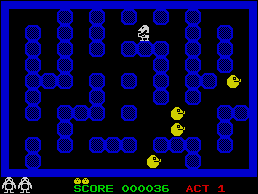
WHEN penguins are not jumping off icebergs for David Attenborough, they spend their time hunting snow bees. If you have never heard of snow bees, it is probably because the penguins are very good at killing them. That peculiar ecological cycle is demonstrated in a new game from Profisoft, a West German software company.
In Pingo you are the penguin, inhabiting a maze of ice blocks. The deadly snow bees will kill you if you touch, but they can be destroyed by pushing blocks of ice into them. Pushing the blocks of ice alters the configuration of the maze, so there is scope for strategic thinking as well as quick reactions in the game.
The graphics have a workmanlike chunkiness about them. New screens involve more bees, so the game rapidly develops into a considerable challenge.
Penguin durch technik, as they say in Germany.
Chris Bourne
| PINGO | Memory: 48K | Price: £5.95 | Joystick: Cursor | Gilbert Factor: 6 |
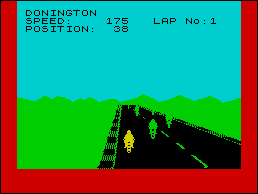
GRAND PRIX motorcycling has increased in popularity tremendously over the past few years, so it was probably inevitable that someone would attempt to simulate the sport on a computer. Following the path blazed by Psion with the Formula One simulation, Chequered Flag, Micromega have produced Full Throttle, a hair-raising version of the Grand Prix 500cc TT races.
The game involves a race against forty bikers around any one of ten carefully simulated tracks. The controls are simple - accelerate, decelerate, left and right. There is also a practice mode to give you a chance to familiarise yourself with the track.
The simulation is not as accurate as Chequered Flag, with 0-175mph in under three seconds, but the controls are extremely sensitive, and the bobbing and weaving of the riders lends considerable atmosphere. You should aim to take the left-handers fast and the right-handers slow - if you hit the edge of the track you lose speed, and if you collide with another rider your speed drops to zero.
Graphics are not of the best quality, but on the whole match Chequered Flag, with a similar mountainous horizon and smoothly shifting track. The bikes themselves flicker, but with at least three or four in view at a time that is not surprising.
Beware; Full Throttle is maddeningly difficult. It took us many hours to achieve 39th out of 40 on the easiest circuit; the best attempt was 25th in Yugoslavia. Despite that the game is as addictive as any race game on the market.
Chris Bourne
| FULL THROTTLE | Memory: 48K | Price: £6.95 | Joystick: Kempston, Protek, Interface 2 | Gilbert Factor: 8 |
BLOCKBUSTER, from Compusound, is a two-tape package with the second tape bearing a new set of questions for this quiz.
On LOADing there is a choice of one or two players, sound and difficulty level ranging from one to nine. A board containing boxes marked with letters appears on the screen and whichever player answers a question correctly can choose another letter.
The difficulty levels are mainly dependent on speed of response for the player has to be very quick to answer the question, and at that level the computer response is always correct. Playing with two players requires a fast response on the part of either player.
As the questions are confined to a particular type, that of knowing the word that fits the description, the value of the program in educational terms is in practising definitions and spellings. Apart from that, Blockbuster is fun to play and reasonably priced.
Theo Wood
| BLOCKBUSTER | Memory: 48K | Price: £5.95 | Gilbert Factor: 7 |
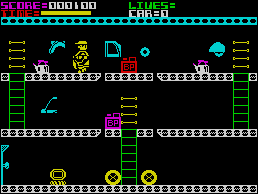
MANIC MINER has set a standard which is very hard to beat and there are by now many variants on the split-level hazard avoidance game. Automania, produced by Mikro-Gen, is one respectable version.
The scenario is a garage workshop where Wally, the rather untidy mechanic, is attempting to assemble cars. Wally must negotiate suitably automobilic hazards to leave the workshop and enter the stock room to collect the next part for the car he is putting together.
On the ground floor tyres bounce along and must be jumped over to avoid instant termination. Ladders lead to the two other tiers. Those platforms have moving gaps. If Wally falls he is killed. There are also various items littered about which must be hurdled. The hazards change after each car is completed and become progressively more difficult, though the format is essentially the same. That results in a repetitive quality which, if you're not overkeen on the scenario, can seem monotonous after a while.
The graphics are bold and colourful and Wally responds well to the controls, though he strolls along at a leisurely pace to make jumping more hazardous. There is a full demo mode, high score facility and timer. Mikro-Gen also offer a £100 prize for the month's highest score. Although the alternative title on the insert is 'Manic Mechanic', this program, whilst difficult and well-made, does not have the range of screens of Miner Willy's nightmare world and loses out by inviting comparisons.
Richard Price
| AUTOMANIA | Memory: 48K | Price: £6.95 | Joystick: Kempston, Interface 2 | Gilbert Factor: 6 |
DEEP IN space, the giant colony ship Snowball hurtles towards its destination in the system of Eridani A. Formed of ten enormous passenger discs, within which sleep millions of pioneers, the vessel is powered by accelerator units fuelled with ammonia ice. The ice is wrapped in a mass around the discs and gives the ship its name.
All the ship's functions are carried out by machines and the eerie passages of the vessel are patrolled by Nightingales, dangerous robot guards. But ... something has gone wrong aboard Snowball and you - Kim Kimberley, the ship's security agent - are woken from hibernation. Snowball is heading straight into the nuclear hell of its target star.
Those are the bones of the plot of the Level 9 classic text-only adventure Snowball. As with all their adventures no space is wasted on graphics and the program is enormous, having 7,000 locations, hundreds of messages and tricky puzzles to solve. The number of locations is achieved by having each passenger disc designed exactly alike. Another innovation is a woman as the central character and the scenario itself is consistent and well-planned, depicting a believable science fiction world.
To score you must achieve significant steps in your attempt to reach the control unit and everything you find will have some sort of function. Working out those functions is a major aspect of the adventure. First you must escape from your freezer coffin and assemble a space suit. On your journey through the immense vessel you will be given lengthy location descriptions befitting the complexity of the Snowball and there is a wealth of detail to take in. The setting is highly atmospheric and imaginative. The interpreter will accept relatively complex language and is versatile in its responses, a feature which enhances the overall effect.
The accompanying booklet gives the player a background summary of the political set-up behind Snowball's mission. Level 9 will also provide cluesheets if required - and you will probably need one.
This is only a brief outline of what is an outstanding adventure. Play it ... you've got a snowball's chance in hell but it's possible you may succeed.
Richard Price
| SNOWBALL | Memory: 48K | Price: £9.90 | Gilbert Factor: 9 |
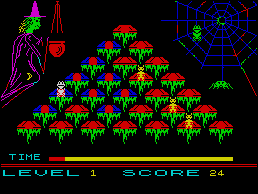
TURNED into a toad by the spells of Griselda the Necromancer, you must race down a pyramid of steps to escape from the fortress. Every step must be covered before escape is possible. Devils, skulls and ghosts chase you round the pyramid threatening instant death.
This is the Q-bert style arcade format of Spellbound from Beyond Software. You have three lives on each of the twelve levels. The skins of previous lives hang in a spider's web above the playing area and lightning bolts shoot from the cauldron where Griselda sits stirring. Timer and current score are shown beneath the pyramid. The attacking creatures multiply from level to level and your chances get slimmer.
The insert does not specify any joystick simply suggesting that a 'relevant' one be used. Certainly there is no great advantage in a stick as the toad hops rather than glides. And with a stick it is tempting to hold on too long and vanish in a puff of smoke over the edge.
A fine game which will keep pyramid addicts on the edge of their sarcophagi.
Richard Price
| SPELLBOUND | Memory: 48K | Price: £5.95 | Joystick: Not specified | Gilbert Factor: 7 |
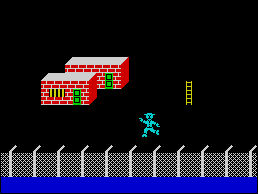
ALCATRAZ Harry, from Mastertronic, captures the essence of prison life brilliantly - intense boredom. It is a maze game in which you must find secret files and amass equipment before escaping.
The maze is a grid containing a scattered selection of revolvers, ladders, wirecutters and similar objects. There are also guards to complicate the route.
The graphics are flickery, and although there are a great number of screens, there is very little detail in each one; a few simple buildings or a watchtower at best. Movement is slow, and although the scenario seems promising at first, it rapidly palls through lack of variety.
For the low price, the game is adequate. But in terms of quality, the game falls way short of what is possible.
Chris Bourne
| ALCATRAZ HARRY | Memory: 48K | Price: £1.99 | Gilbert Factor: 3 |